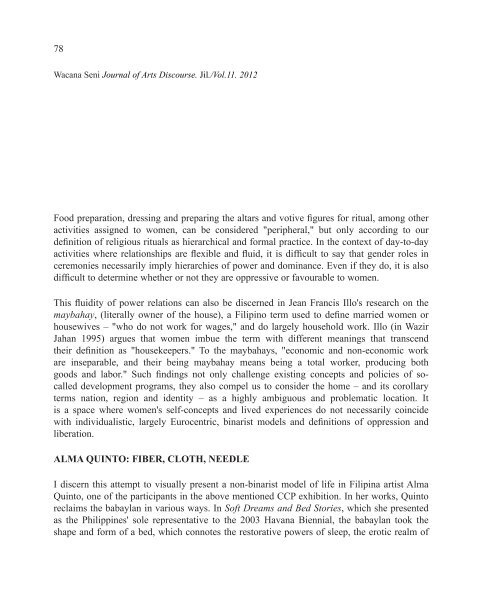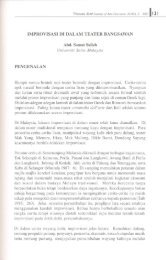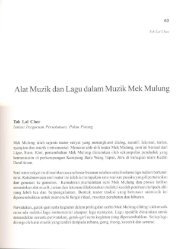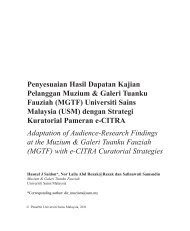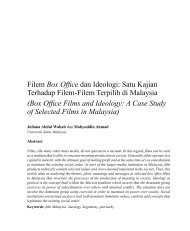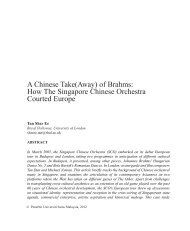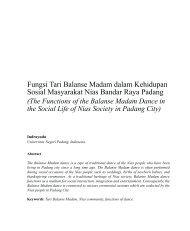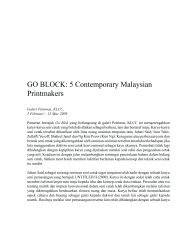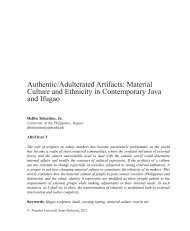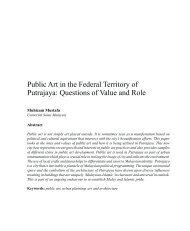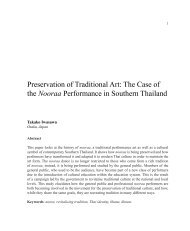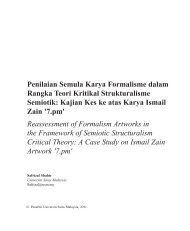Reclaiming The Healing Arts of The Ancient ... - Wacana Seni
Reclaiming The Healing Arts of The Ancient ... - Wacana Seni
Reclaiming The Healing Arts of The Ancient ... - Wacana Seni
You also want an ePaper? Increase the reach of your titles
YUMPU automatically turns print PDFs into web optimized ePapers that Google loves.
78<strong>Wacana</strong> <strong>Seni</strong> Journal <strong>of</strong> <strong>Arts</strong> Discourse. Jil./Vol.11. 2012Food preparation, dressing and preparing the altars and votive figures for ritual, among otheractivities assigned to women, can be considered "peripheral," but only according to ourdefinition <strong>of</strong> religious rituals as hierarchical and formal practice. In the context <strong>of</strong> day-to-dayactivities where relationships are flexible and fluid, it is difficult to say that gender roles inceremonies necessarily imply hierarchies <strong>of</strong> power and dominance. Even if they do, it is alsodifficult to determine whether or not they are oppressive or favourable to women.This fluidity <strong>of</strong> power relations can also be discerned in Jean Francis Illo's research on themaybahay, (literally owner <strong>of</strong> the house), a Filipino term used to define married women orhousewives – "who do not work for wages," and do largely household work. Illo (in WazirJahan 1995) argues that women imbue the term with different meanings that transcendtheir definition as "housekeepers." To the maybahays, "economic and non-economic workare inseparable, and their being maybahay means being a total worker, producing bothgoods and labor." Such findings not only challenge existing concepts and policies <strong>of</strong> socalleddevelopment programs, they also compel us to consider the home – and its corollaryterms nation, region and identity – as a highly ambiguous and problematic location. Itis a space where women's self-concepts and lived experiences do not necessarily coincidewith individualistic, largely Eurocentric, binarist models and definitions <strong>of</strong> oppression andliberation.ALMA QUINTO: FIBER, CLOTH, NEEDLEI discern this attempt to visually present a non-binarist model <strong>of</strong> life in Filipina artist AlmaQuinto, one <strong>of</strong> the participants in the above mentioned CCP exhibition. In her works, Quintoreclaims the babaylan in various ways. In S<strong>of</strong>t Dreams and Bed Stories, which she presentedas the Philippines' sole representative to the 2003 Havana Biennial, the babaylan took theshape and form <strong>of</strong> a bed, which connotes the restorative powers <strong>of</strong> sleep, the erotic realm <strong>of</strong>


